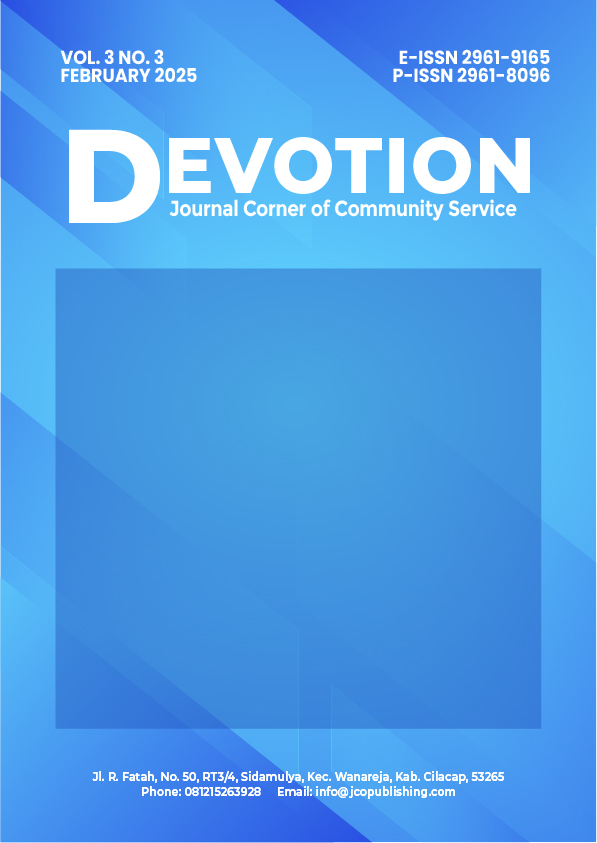Pelatihan Pembuatan Produk Inovatif Berbasis Tempe untuk Peningkatan Ekonomi Masyarakat
 https://doi.org/10.54012/devotion.v3i3.337
https://doi.org/10.54012/devotion.v3i3.337
 Abstract views: 152
Abstract views: 152
 PDF (Bahasa Indonesia) downloads: 83
PDF (Bahasa Indonesia) downloads: 83
Keywords:
Inovasi Produk, Keripik Tempe, Pelatihan, Ekonomi MasyarakatAbstract
Tempeh is an original traditional food from Indonesia which is a cultural heritage of the noble culture of the Indonesian nation. Tempeh is a super food or food that is rich in nutrients. Tempeh innovation can be used as a variety of food that can increase the economic value of the community. Partners' problems include the lack of community skills on how to process tempeh into various kinds of foods that are attractive and have high nutritional value. The solution offered is to provide education and training on the skills of making various processed tempeh products, one of which is making tempeh chips. Community service activities are carried out with four stages of activities, namely identification, preparation, implementation and evaluation. Identification of the problems faced, preparatory activities include taking care of permits, the implementation of activities includes training in making tempeh chips as an effort to innovate products and demonstrations of making tempeh chips. Participants were enthusiastic in participating in the training until it was finished. The training on making tempeh chips as an effort to innovate products runs smoothly, can improve the community's economy and participants follow enthusiastically.
References
D. Puspita Dewi, K. Astriana, D. Arthyka Palifiana, and D. Erfanda, “Pembuatan Olahan Tempe Sebagai Upaya Diversifikasi Pangan,” Pengabdi. Univ. Respati Yogyakarta Vol. 1 No. 1, vol. 1, no. 1, pp. 113–117, 2022.
T. Maryati, H. Rimiyati, and N. Jannah Fadilatul, “Pendampingan Pengabdian Masyarakat Ukm Tempe,” WEBINAR ABDIMAS 3 - 2020 Inov., no. 2013, pp. 68–75, 2020.
S. Ani, G. Giyatmi, and E. S. Paranita, “Pengabdian Kepada Masyarakat Penentuan Biaya Produksi Tempe Pada Kampung Industri Kecil Pengrajin Tempe Kecamatan Pamulang Kota Tangerang Selatan,” J. Pengabdi. Kpd. Masy. Nusant., vol. 6, no. 1, pp. 1255–1260, 2024.
Y. Rahmawati and S. Dhewantara, “Strategi Pemberdayaan Kripik Tempe Melalui Media Sosial di Sukoharjo,” Amaluna J. Pengabdi. Masy., vol. 1, no. 1, pp. 1–7, 2022, doi: 10.21154/amaluna.v1i1.761.
H. Herlina, A. Purnamasari Bida, E. A. Agung, and S. Nur, “2024 Nanggroe : Jurnal Pengabdian Cendikia Pelatihan Pembuatan Tempe Dari Beberapa Jenis Bahan Baku Kacang- Kacangan Kepada Mahasiswa Universitas Patompo Untuk Pengembangan Wirausaha 2024 Nanggroe : Jurnal Pengabdian Cendikia,” Nanggroe J. Pengabdi. Cendikia, vol. 3, no. 5, pp. 39–44, 2024.
D. A. Puryono, L. E. Sudiati, and ..., “Pendampingan Umkm Keripik Tempe Desa Langse Kecamatan Margorejo Dalam Mendesain Label Produk,” J. Pasopati Pengabdi. Masy. dan Inov. Pengemb. Teknol., vol. 4, no. 2, pp. 103–108, 2022, [Online]. Available: https://ejournal2.undip.ac.id/index.php/pasopati/article/view/14029
S. Christiani and L. Widjaja, “Pendampingan Pengabdian Masyarakat Ukm Cokelat Tempe Di Kampung Tematik Tempe Kelurahan Koang Jaya Kota Tangerang,” Servecivitatis, vol. 1, no. 1, 2022.
C. Sundaygara, D. Wahyuningsih, K. B. Pranata, and S. Solikhan, “Pengabdian Perbaikan Fasilitas Mesin Produksi Keripik Tempe di Panti Asuhan Bhakti Luhur,” JAPI (Jurnal Akses Pengabdi. Indones., vol. 4, no. 1, p. 42, 2019, doi: 10.33366/japi.v4i1.1219.
Downloads
Published
How to Cite
Issue
Section
License
Copyright (c) 2025 Sodirin, Senen Mustakim, Bustami Zainudin, Ahmad Hudalil, Redi Pinaloka

This work is licensed under a Creative Commons Attribution-ShareAlike 4.0 International License.





